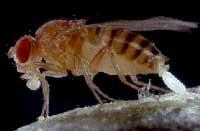Review genome fly drosophila
2001/05/17 Roa Zubia, Guillermo - Elhuyar Zientzia
Celera Genomics, in addition to the human genome, sequenced and published last year the fly genome Drosophila Melanogaster. Now, a group of scientists at Stanford University in California have done an analysis of what was published.
The journal Nature today publishes the conclusions of the study. This brief communication begins with the following reflection: "Although there are great consensus in many gene sequences, there are many significant discrepancies."

From sequenced data, Celera Genomics tried to predict coded genes. It was announced that the drosophila fly had 14,226 genes, including another 550 that could exist in unknown combinations. But this fly has been widely used in laboratories, so the world's biochemists have stored the data collected for years in a database. This database is called SwissProt. Stanford scientists have compared these two data sources. It should be noted that these scientists are mathematicians, experts in databases.
The comparison was made with a sample of 1,049 genes taken from the SwissProt database. Only 26.2% of genes compared to company data were identical. 28.8% have equal data in length but modified. The remaining genes had significant differences (over 1%) in the sequences specified in both sources.
The SwissProt database has collected a long time work, so many times it has already been verified. This short article in the journal Nature questions the reliability of the methodology developed by the company. According to the authors, the use of data from the Drosophila genome considerably limits the investigation of the proteome and probably this conclusion will also serve for the case of the human genome.

Gai honi buruzko eduki gehiago
Elhuyarrek garatutako teknologia




